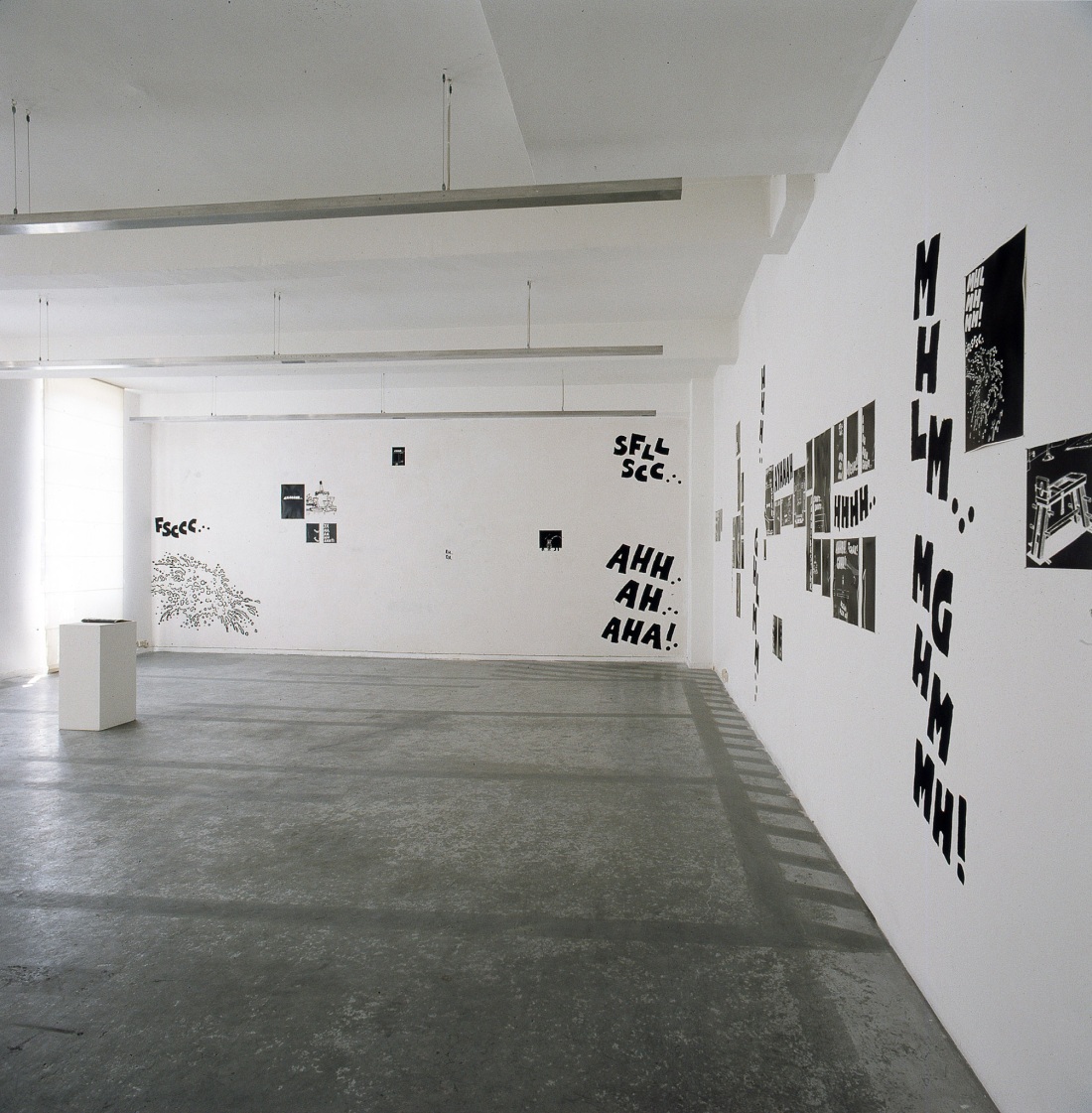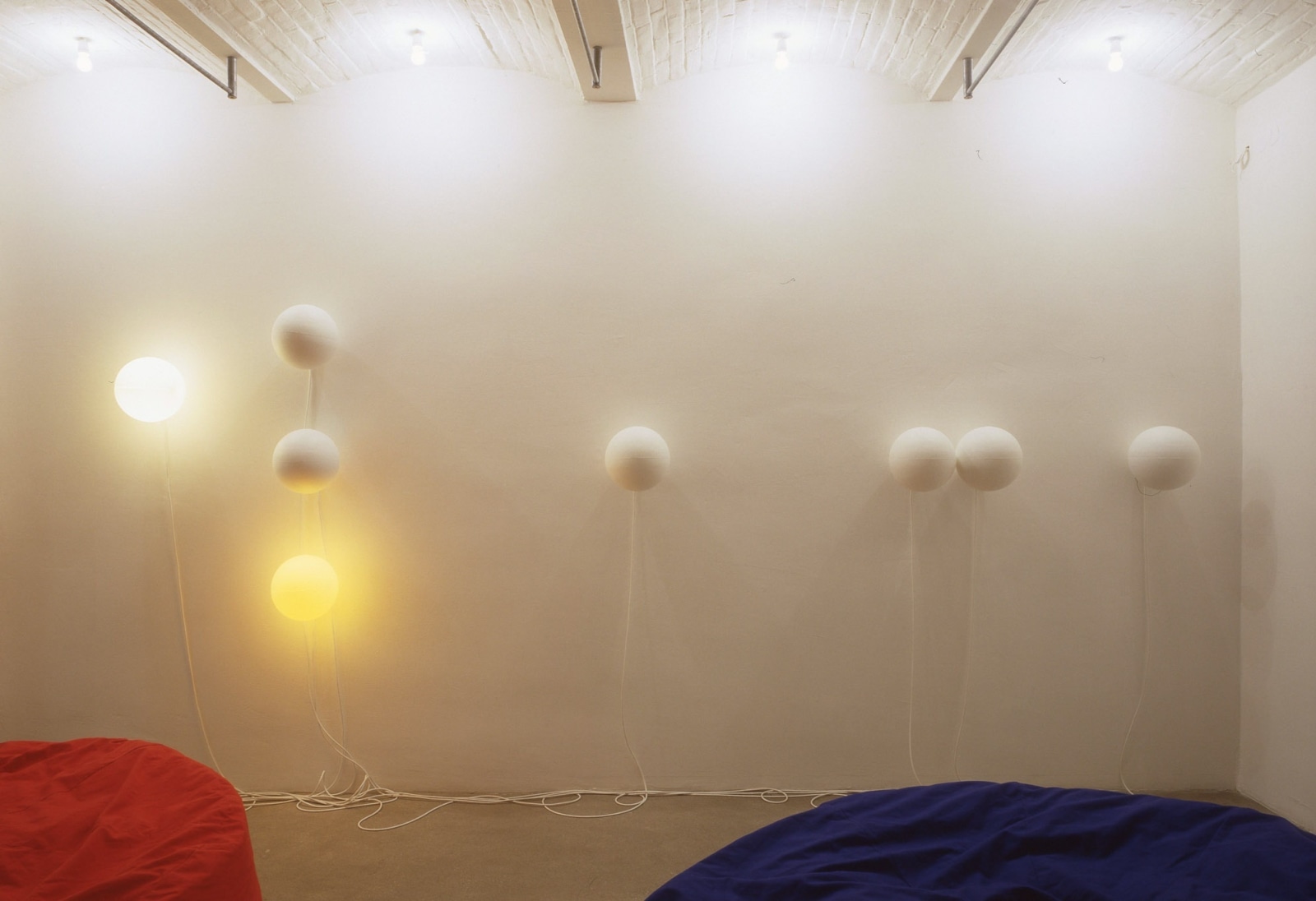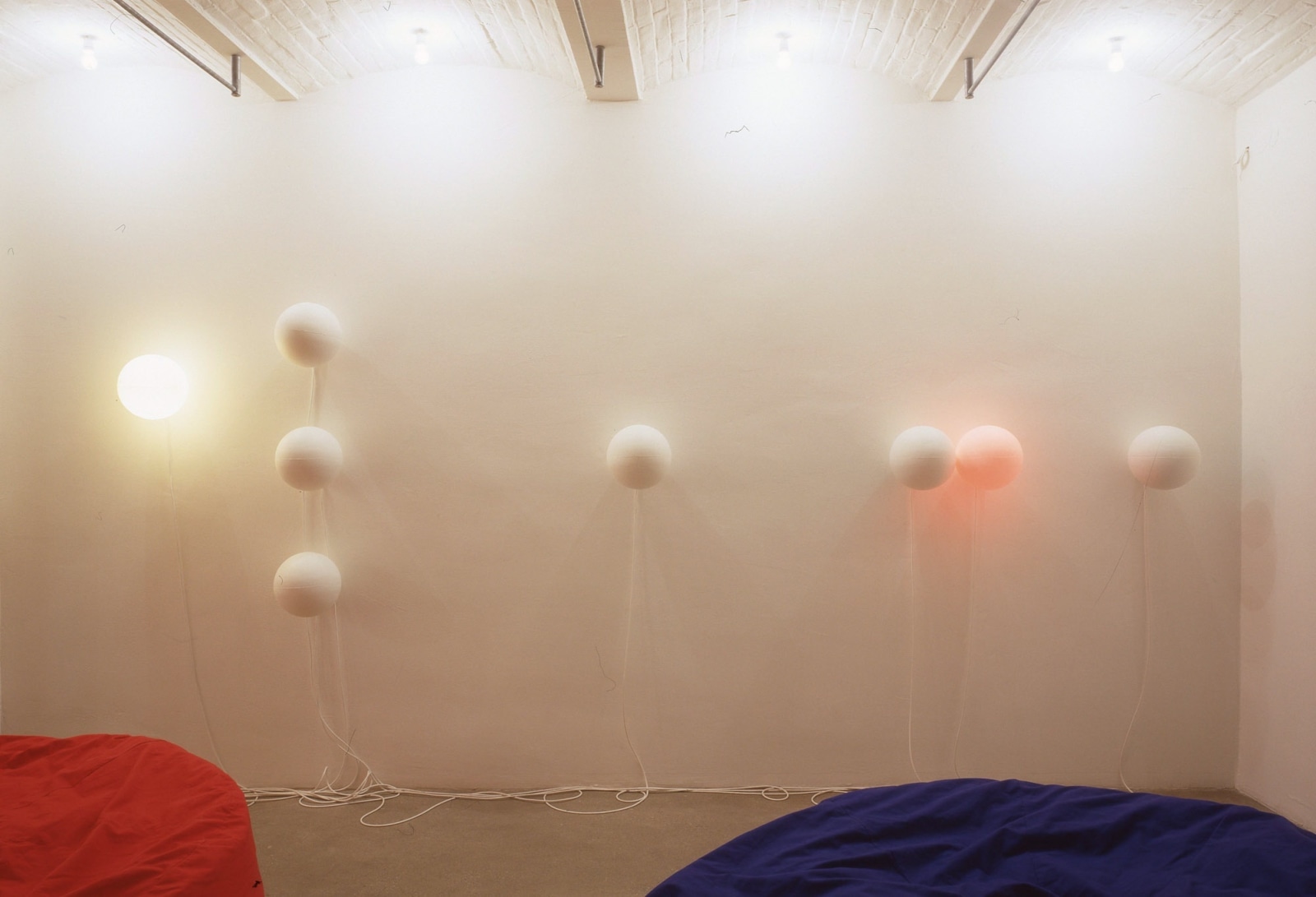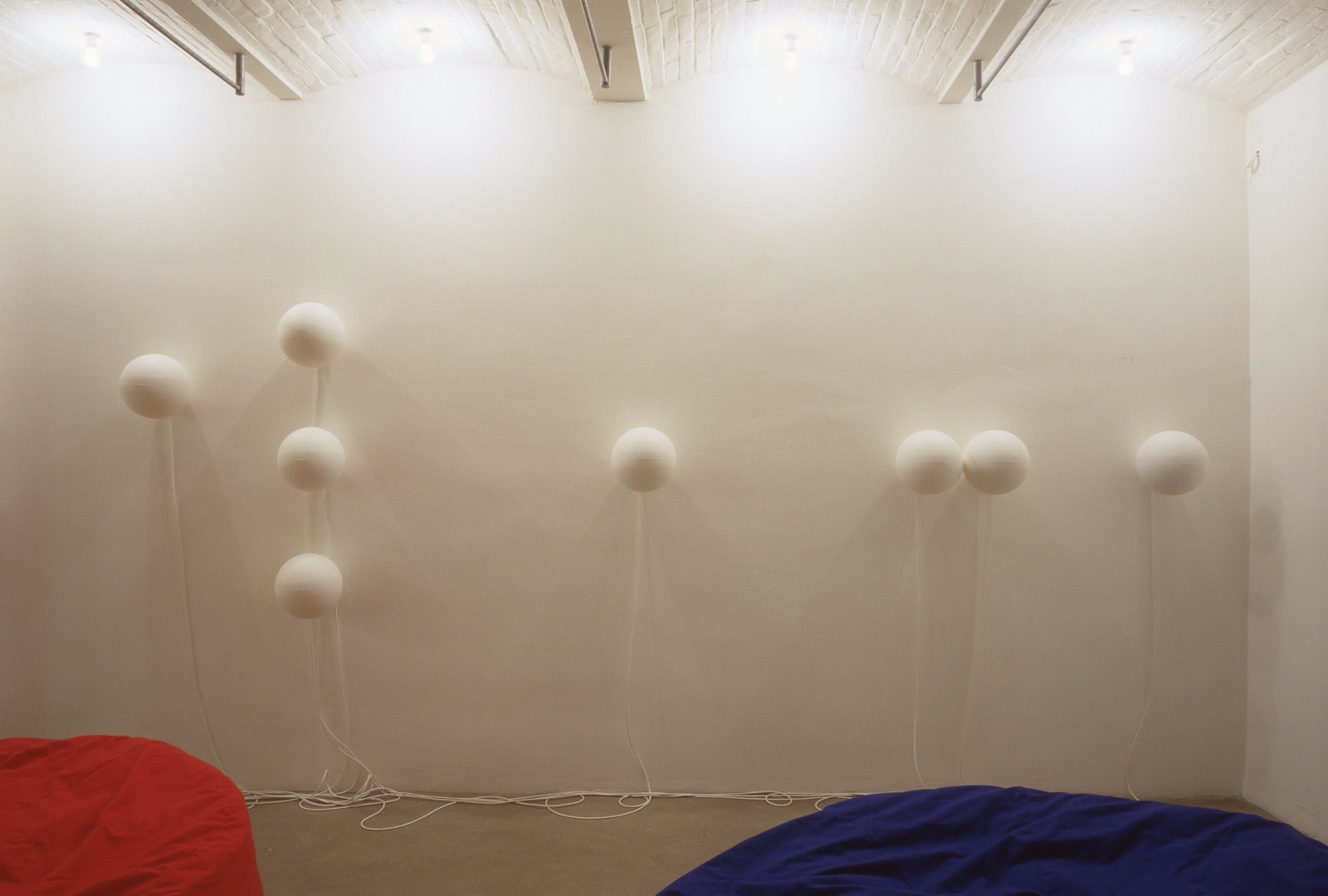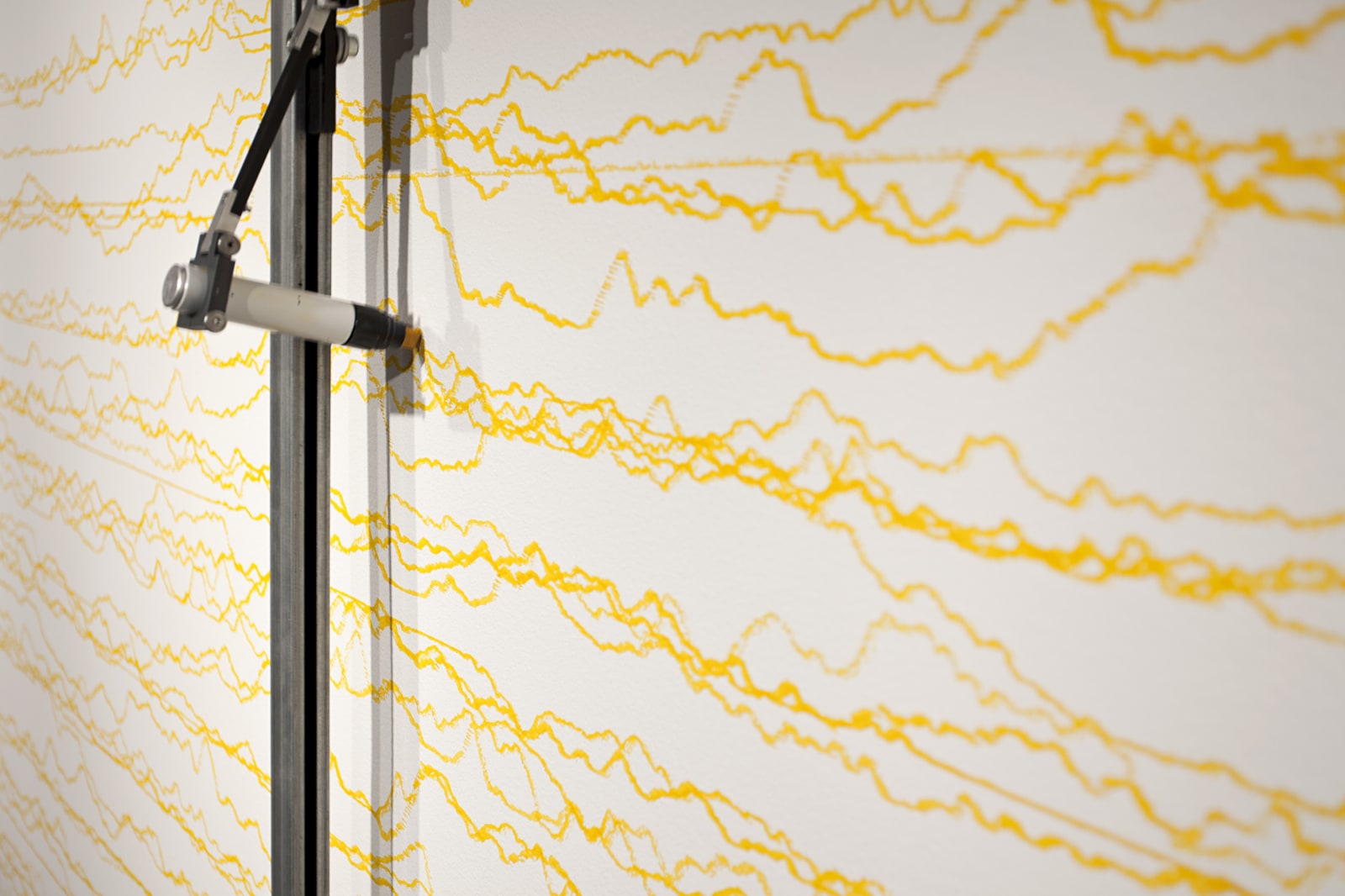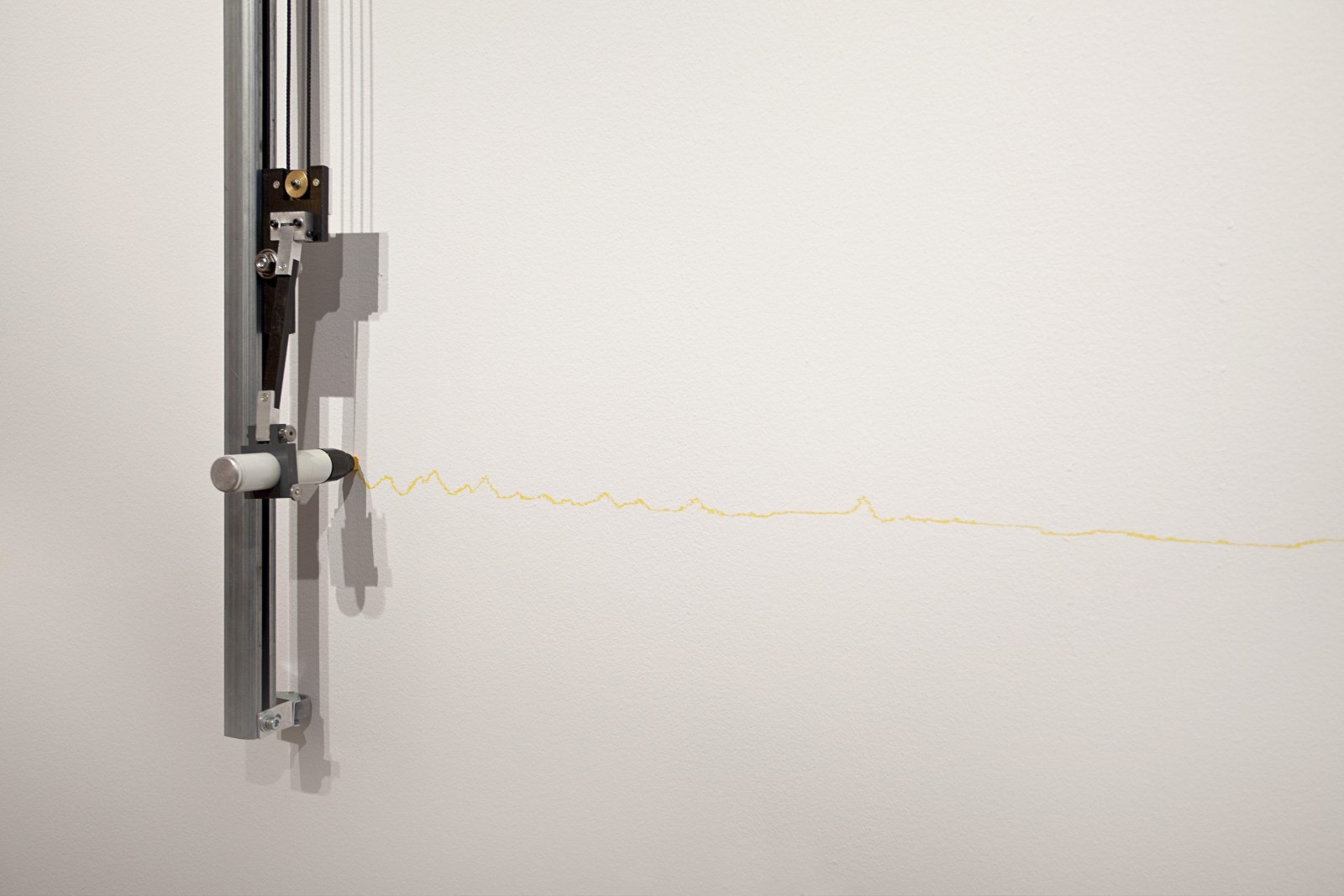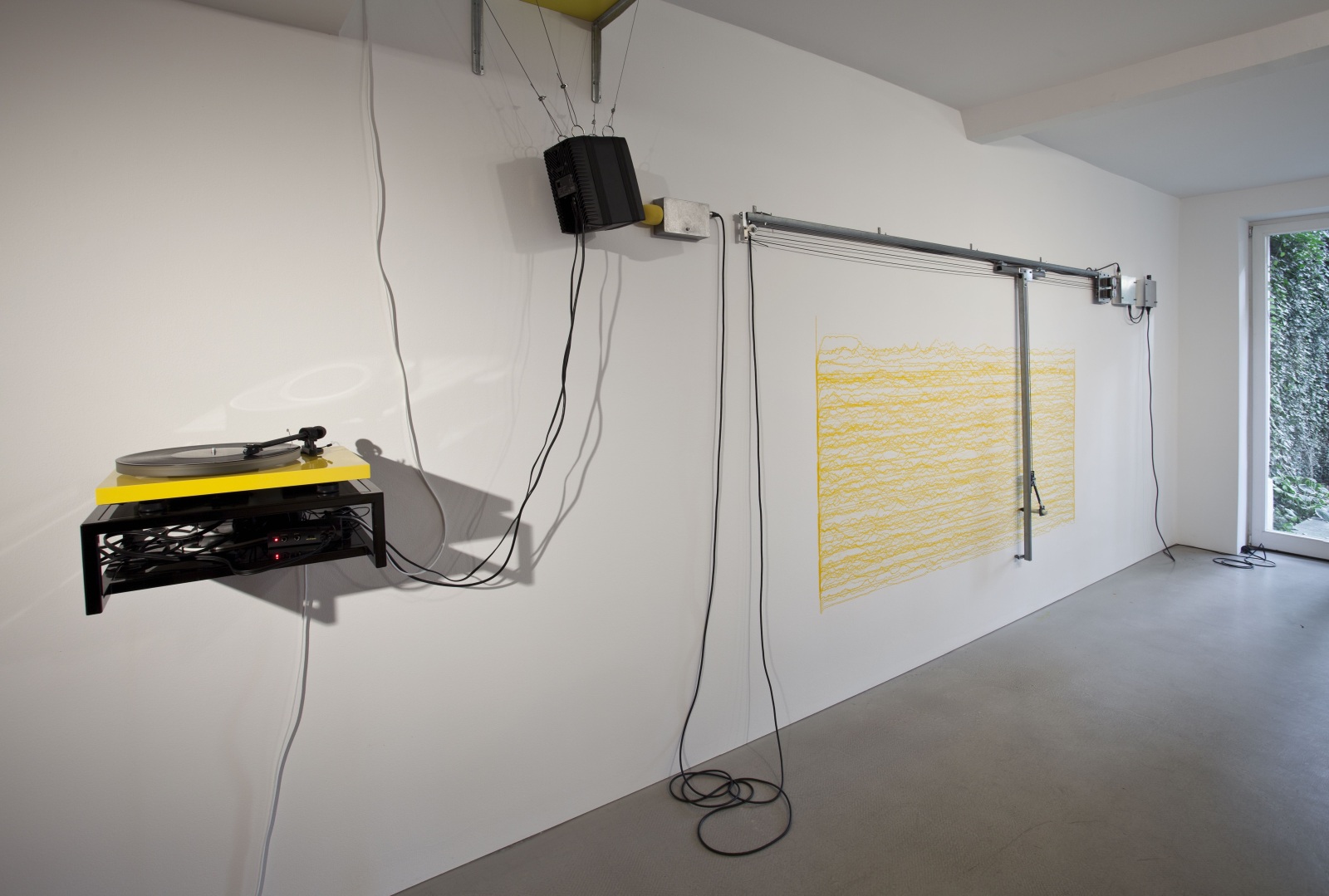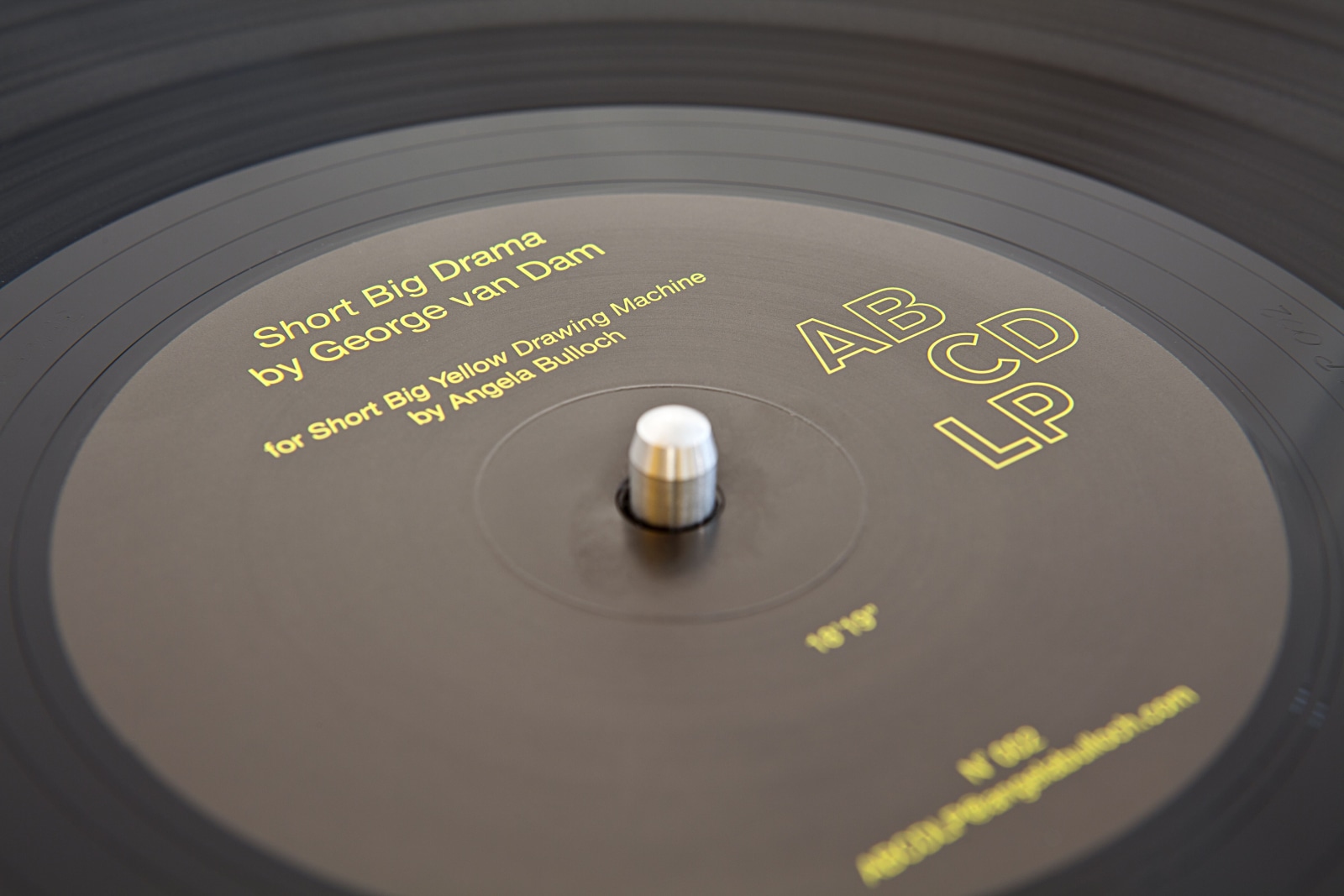Angela Bulloch has been with the gallery from the very beginning. The artist has had thirteen solo exhibitions and her work has been included in countless of the gallery’s group presentations.
We celebrate the thirty-year anniversary of her first solo exhibition with Esther Schipper with an Online Viewing Room which includes historical documentation, information on all her major bodies of works, and video content.
Angela Bulloch
Angela Bulloch was born 1966 in Rainy River, Ontario, in Canada. She studied at Goldsmiths College, University of London. The artist lives and works in Berlin.
In 1997, Bulloch was nominated for the Turner Prize and in 2005, for the Berlin-based Preis der Nationalgalerie für junge Kunst. In 2011, she received the Vattenfall Contemporary Art Prize, Berlin, as well as the Art Prize of the city of Wolfsburg.
Angela Bulloch's work spans many media, manifesting her interest in systems, patterns and rules, as well as her preoccupation with the history of shapes and human interaction. Her recent series of sculptures combines her interest in the logic of geometry and seriality with a graphic quality. The appearance of the sculpture shifts according to one's point of view: from one side the irregular aspect dominates, while from another, the impression of a certain totemic regularity prevails.
Bulloch's recent solo exhibitions include: Anima Vectorias, MAAT, Lisbon (2019); Angela Bulloch, Omi International arts Center, The Fields Sculpture Park, Ghent, NY (2017); Considering Dynamics & The Forms of Chaos, Sharjah Art Museum, Sharjah (2016); Short Big Drama, Witte de With, Rotterdam (2012); Time & Line, Städtische Galerie, Wolfsburg (2011), and Information, Manifesto, Rules And Other Leaks…, Vattenfall Contemporary Art Prize, Berlinische Galerie, Berlin (2011).
Her work is held in the following public collections: National Gallery of Victoria, Melbourne; Sammlung Neue Galerie am Landesmuseum Joanneum, Graz; FRAC Languedoc-Roussillon; FRAC Poitou-Charentes; FNAC, Puteaux; Fondation Louis Vuitton, Paris; Le Consortium, Dijon; Centre Pompidou, Paris; Estuaire, Nantes; Bundeskunsthalle, Bonn; The Schaufler Foundation, Sindelfingen; Städtische Galerie im Lenbachhaus und Kunstbau, Munich; Kunstmuseum, Bonn; Berlinische Galerie, Berlin; Sammlung Städtische Galerie, Wolfsburg; De Pont, Tilburg; Helga de Alvear, Madrid; Collection Ringier, Zurich; Collection Guggenheim Abu Dhabi, UAE; Tate, London; Arts Council Collection, London; Museum of Art, Rhode Island School of Design, Providence, Rhode Island; Goss Michael Foundation, Dallas, Texas, and Phillips Collection, Washington, D.C.
Angela Bulloch, Gary Hume, Michael Landy, 1989
Esther Schipper and Angela Bulloch met in London in 1988 when the artist was studying at Goldsmiths College.
A year later, Esther Schipper opened her first gallery in Cologne. Her first group exhibition with Angela Bulloch took place between October 12 and November 11, 1989, during the period that led to the fall of the Berlin wall.
The presentation brought together three works from Bulloch's Light Switch series, together with installations by Gary Hume and Michael Landis.
Each work in the series consists of opalescent polycarbonate spheres with colored light bulbs. The light switches from one sphere to the other at regular intervals, while the light is on in only one sphere at any one time.
Angela Bulloch, 1990
Angela Bulloch's first solo exhibition with Esther Schipper opened in Cologne on November 16, 1990.
The exhibition consisted of one large-scale installation, the artist's Drawing Machine Blue Horizons II repurposed the mechanics of Bulloch's first-ever Drawing Machine conceived earlier that year.
In a wide horizontal format approximately the ratio of 1:2, the wall drawing consisted of a blue field of vertical, horizontal and diagonal lines, giving the strong impression of a loosely woven diamond-shaped pattern. The machine comprised a horizontal top bar from which hung two parallel vertical rods that supported a sled with the writing marker.
— Christian Rattemeyer, Time & Line, Hatje Cantz Verlag, 2012, p. 24.
Instead of a durable and permanent marker, Blue Horizons II used disappearing, water-based ink which changed over time as it was exposed to sunlight.
The Drawing Machine was triggered by a combination of sound-activated sensors connected to microphones scattered around the exhibition space and a pressure switch embedded in the seating arrangement in front of the wall drawing.
A work is an interactive work when there is an already existing knowledge in the mind of the viewer that he or she will affect the work by engaging with it physically somehow. With an interpassive work the engagement of the viewer is discovered at the moment the work is completed by the presence of the viewer.
— Angela Bulloch
MHLM...MGHMMH!, 1992
All the images were taken from one story in a Milanese S&M comic. At first I reversed the images (from white to black and from black to white) for the whole story. I then removed all the dialogue and people from the images by blacking them out. The result is a series of images of objects and scenes interspersed with noises such as grunts and sighs in large hand drawn comic lettering. After editing the story down to about sixty-nine images I then produced photographs and wall drawings.
— Angela Bulloch
Each wall painting was made by projecting a 35mm slide-to serve a stencil-onto the wall and then painted directly onto the wall following the edge of the projected outline.
Rules Series, 1993
Angela Bulloch's 1993 solo exhibition with Esther Schipper marked the beginning of one of her most important body of work: the Rules Series.
The Rules Series’ (1993–ongoing) is a conceptual work consisting of a collection of found rules that intentionally avoids the deadpan rigor of old-school Conceptual Art. Sources and behavioral topics for the rules collection so far include a stripper bar, a video game parlor, the General Standing Orders of the House of Commons, a Russian Modelling School, neighborhood tips in case of riots in Santa Monica, Data Protection Principles and back jeans pocket-handkerchief color codes.
It was in the Baby Doll Lounge in New York where Bulloch found the first set of rules stuck on to the back of the ladies’ toilet door, which also doubled as a changing room for its topless dancers.
There are rules for the Rules Series that are also part of the series and constitued the main installation in Bulloch's 1993 exhibition at Esther Schipper, Cologne:
1. The rules are lists of rules that pertain to particular places, practices or principles.
2. Each list is an individual work; however it is also part of a series.
3. Each list is a unique piece with no fixed form; however a collection of ten lists has been produced as a printed edition of 20.
4. Each unique piece is accompanied by this list, which becomes a certificate when titled and signed by the artist.
5. The unique pieces have no form; buying one confers the right to produce or reproduce the piece in any form or medium.
6. A rules series edition may be photocopied; buying one confers the right to photocopy the lists in any size or colour.
7. The artist asserts the usual moral rights and copyrights.
In addition to her exhibition at the gallery — then located on Neusserstrasse 28 — Bulloch presented nine other works from her Rules Series, dispatched in the city of Cologne over the course of September 1993.
In this picture, artists Carsten Höller and Wolfgang Tillmans, as well as gallerist Daniel Buchholz can be seen reading the artist's Data Protection Rules inscribed on a restaurant's blackboard.
Mud Slinger, 1995
In 1995, Angela Bulloch presented a site-specific installation titled Mud Slinger. The exhibition focused on the essentials of painting as a cultural technique, relating the artistic process to the creative force of a child “that has yet to acquire the orders later prescribed and the methods of organization that duly inform the dogma of our general and socialized understanding of art.” For this installation, Angela Bulloch used mud as a painting material, which she applied by means of an electric pump.
Codes, 1998
Inaugurated on May 27, 1998, at Schipper & Krome in Cologne, Angela Bulloch's fifth solo exhibition was titled Codes. The exhibition consisted of three new works that presented a further development in the artist's light works and Rules series.
One of the main works included in the exhibition, Snooker – Start Of An End Game was a non-interactive light work. The installation referred to the English snooker game both in color (black, red, pink, blue, green, brown, yellow and white) and in its arrangement/installation.
The three-part Triple Donut/Toadstool RYB, 1998, a modularly conceived beanbag group, was an independent work, but one that referred to the light installations.
Blow_Up T.V., 2000
Angela Bulloch's Pixel Boxes have become her most familiar work. In 2000, Bulloch presented her first prototypes at Esther Schipper, Berlin, as part of her solo exhibition Blow_UP T.V.
The 2000 exhibition press release read:
A pixel is the smallest conceivable picture element, which makes sense in a semantic way only when appearing within a group. When the square of light made by a single pixel is 50 x 50 cm, the distance between the viewer and the group of pixels must be large in order to discern the image.
The new pixel modules are complex RGB lighting systems, which are capable of creating millions of colors within the defined format of 50 x 50 x 50 cm. They can be generated and programmed with any digital information. The pixel modules were developed by Angela Bulloch and Holger Friese.
The space created by Angela Bulloch for this exhibition consists of different arrangements of pixel boxes. The sequence of images within these works was taken from the film Blow Up.
Angela Bulloch utilizes a key visual from the film Blow Up by Michelangelo Antonioni. The photographer, hiding behind a tree taking photos of a couple walking in the park. Later in the film, he blows up the photos to discover a murder.
In BLOW_UP T.V. this process of identification is extended by yet another magnification, exploding the image within a modular system.
Initially fabricated in beech wood with a glass front screen, Bulloch's Pixel Boxes' softly changing and pulsing colors distill and abstract complex visual patterns into simple-shifting monochromes.
Bulloch’s works span many forms, but they all manifest her interest in systems, patterns and rules, and the creative territory between mathematics and aesthetics. A common thread in her artistic practice is the manipulation of codes and a sense of control. Whether that code is music- or text-based, the artist plays with and orchestrates our perception and experience of art. She proposes that this experience can be ‘subliminally programmed’ and her work stages that which is beyond our grasp.
Macro World: One Hour3 and Canned, 2002
Two years later, Angela Bulloch presented a new development of the pixel module, which dealt even stronger than before with the connection between the media and everyday life.
The early 2000s trend towards an interchangeability of globalised TV formats was condensed into a pixel wall of 2,50 x 3,50 m as a carrier of abstracted visual information.
In Macro World: One Hour3 and Canned Angela Bulloch used material from BBC World: World News, Global Weather — the topography of an invisible world, presented to us merely as a map and as standardised, depersonalized platform. Every hour on the hour, at BBC World, an almost perpetually uniform program is broadcast worldwide, 24 hours a day, seven days a week.
In the hour-long cycle of material there are deliberate mistakes placed into the program. They can be seen at intervals throughout the loop: A single pixel of a strange colour appears within the fractured image and grows across the screen. The mistakes block out the already not quite recognizable images of talking heads or landscape scenes, exactly the kind of images you see on standardised news programs like BBC World. An ambient sound track featuring the BBC World's corporate sound identity, called BBC World: The Music by David Lowe, accompanies the loop.
The work is 'framed' by a raised floor made of Euro palettes and a lowered ceiling of plastic mirror tiles.
The stargate scene shows two seemingly infinite planes of exposure rushing past but instead of going across the picture plan from left right, the landscapes come straight at you in a stream of whirling lights and colors. This sequence was made from a combination of aerial landscape footage overlaid with brightly colored chemicals interacting. The horizon is visible in the first part and therefore you gain a sense of gravity and orientation, which is lost again in the following part of the piece. The ground falls away and the experience becomes somehow extra-terrestrial.
— Angela Bulloch
Are you coming or going, around?, 2007
Are you coming or going, around?, Bulloch's 2007 solo exhibition with the gallery marked the beginning of a new body of work. The title of the exhibition was a play on words on the idea of orbiting or running around in circles — in this case, understood in opposition to the linear-teleological concept of progress.
For this exhibition, the artist introduced the first iteration of the now-iconic Night Sky series. Night Sky works are prepared using a program that maps the positions of the stars visible from the earth in a 3D virtual model of the universe. The artist selects an existing area of the sky but displaces the viewpoint away from Earth elsewhere in the universe, thus the final image represents the real stellar order but shown in a way that will never be seen from the earth. The change of perspective allows us to contemplate a myriad of possible ways of seeing the formations of the universe.
REDUX, 2010
With REDUX, Angela Bulloch carried out a systematic survey of her own artistic repertoire of forms. The exhibition resembled a laboratory, with earlier works like the Rules Series and the Pixel Boxes as starting points for a test arrangement.
In this new exhibition REDUX, Bulloch has chosen to go forward while casting a glance back over her shoulder. The premise of the exhibition is as its title REDUX suggests a kind of revisiting and new extension of ideas and materials and formal approaches from past works — including the idea of the pixel box — but re-sampled, re-mixed, reconstituted and re-reflected. Thus from various prototype and errant pixels arise new pieces with designer extensions, floor to ceiling chords or tails and other individualized augmentations and surface treatments. (...) Other new sculptural works question what happens if the pixel or the flat modernist square were somehow a surface that extended vertically into a sculptural space?
— Dominic Eichler
ABCDLP 002 – Short Big Drama by George van Dam for Short Big Yellow Drawing Machine by Angela Bulloch, 2012
Twelve years after exhibiting her first Drawing Machine at the gallery, Angela Bulloch presented Short Big Yellow Drawing Machine, the eleventh iteration in the series. The work is now in the collection of the National Gallery of Victoria, Melbourne.
The Drawing Machine is activated by sound. In this case, the drawing pattern programmed for the machine creates horizontal lines. The act of drawing is largely predetermined, but deviations are usually caused by shifts in direction, produced by the changing rhythms and volumes of the soundtrack, specifically composed by musician George van Dam.
Entitled Short Big Drama, the composition was played in Bulloch's adjacent installation: Yellow Music Station.
The music was constructed with the machine in mind... according to certain parameters like frequency range, using sounds with accents and short bursts of music with attack... which we preordained because of the machines' proclivities.
— George van Dam
To listen to Short Big Drama composed by George van Dam and released on Angela Bulloch's label ABCDLP, click here. (This link opens in a new tab)..
There is a reverse strategy employed in that the machine becomes an instrument of the music. The machine moves like the music sounds...intense, neurotic perverted even because it seems to be shadowing the music self consciously.
— Angela Bulloch
In Virtual Vitro, 2014
Entitled In Virtual Vitro, Angela Bulloch's eleventh solo exhibition included new contributions to key series in the artist's oeuvre, among them a Music Listening Station playing records issued by her record label ABCDLP, a Drawing Machine, and two Happy Sacks. Displayed on an iPad, a video with an avatar gave a short introduction to the exhibition.
Encountering Bulloch's work has always been an activity, an ongoing experience. This diachronic element was literally built into most of the pieces in the show's first room: watching the machine draw or the Pixel Box change, listening to the music she selected.
Angela Bulloch’s geometrical sculptures consist of several assembled figures known as polyhedra. Conceived and designed within a digital imaging program, each module appears distinct, whilst at the same time relating to the others. Made of either untreated or oiled MDF, Corian (a composite material), or powder-coated steel — which allows them to be installed outside.
Bulloch’s variety of mediums has an ability to provide surfaces that are optically difficult to grasp. Several sides of each modular element have been painted, alternating light, bright or dark colors. This coloring increases the optical illusions of pushing and pulling planes: at times the sculpture seems graphic, seemingly shifting between two and three dimensions. The appearance of each column changes according to one’s point of view. From one side the irregular aspect dominates, whilst from another the impression of a certain totemic regularity prevails.
Heavy Metal Body, 2017
Inaugurating Esther Schipper's new space, located at Potsdamer Str. 81E in Berlin, the exhibition presented three new sculptures and a wall drawing that expanded the body of work that Angela Bulloch had been developing since 2014.
Angela Bulloch’s sculptures and wall paintings, like the rest of her oeuvre, manifest her interest in systems, patterns, and rules, as well as the creative territory between mathematics and aesthetics.
It's really striking how your perception of [Heavy Metal sculptures] shifts at each moment. You’re never quite sure if it’s two dimensional or three dimensional, which somehow seems to translate or relate to its digital origin...
— Suzanne Cotter, Interview with Angela Bulloch, Euclid in Europe, Hatje Cantz Verlag, 2019, p. 59
In this video, Angela Bulloch talks about her work Heavy Metal Stack: Fat Cyan Three (2018), a sculpture commissioned in celebration of The Phillips Collection centennial in 2021.

















